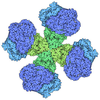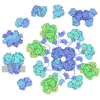[English] 日本語
 Yorodumi
Yorodumi- PDB-9cd4: Cryo-EM structure of Candidatus Saccharibacterium phosphoketolase... -
+ Open data
Open data
- Basic information
Basic information
| Entry | Database: PDB / ID: 9cd4 | ||||||||||||||||||||||||
|---|---|---|---|---|---|---|---|---|---|---|---|---|---|---|---|---|---|---|---|---|---|---|---|---|---|
| Title | Cryo-EM structure of Candidatus Saccharibacterium phosphoketolase complexed with 2-acetyl-thiamine diphosphate | ||||||||||||||||||||||||
 Components Components | Phosphoketolase family protein | ||||||||||||||||||||||||
 Keywords Keywords | LYASE / acetyl-phosphate synthase / glycolaldehyde dehydration / carbohydrate metabolic process / aldehyde-lyase activity | ||||||||||||||||||||||||
| Function / homology |  Function and homology information Function and homology information | ||||||||||||||||||||||||
| Biological species |  Candidatus Saccharibacteria bacterium (bacteria) Candidatus Saccharibacteria bacterium (bacteria) | ||||||||||||||||||||||||
| Method | ELECTRON MICROSCOPY / single particle reconstruction / cryo EM / Resolution: 2.3 Å | ||||||||||||||||||||||||
 Authors Authors | Singal, B. / Landwehr, G. / Jewett, M.C. | ||||||||||||||||||||||||
| Funding support |  United States, 1items United States, 1items
| ||||||||||||||||||||||||
 Citation Citation |  Journal: bioRxiv / Year: 2024 Journal: bioRxiv / Year: 2024Title: A synthetic cell-free pathway for biocatalytic upgrading of one-carbon substrates. Authors: Grant M Landwehr / Bastian Vogeli / Cong Tian / Bharti Singal / Anika Gupta / Rebeca Lion / Edward H Sargent / Ashty S Karim / Michael C Jewett /  Abstract: Biotechnological processes hold tremendous potential for the efficient and sustainable conversion of one-carbon (C1) substrates into complex multi-carbon products. However, the development of robust ...Biotechnological processes hold tremendous potential for the efficient and sustainable conversion of one-carbon (C1) substrates into complex multi-carbon products. However, the development of robust and versatile biocatalytic systems for this purpose remains a significant challenge. In this study, we report a hybrid electrochemical-biochemical cell-free system for the conversion of C1 substrates into the universal biological building block acetyl-CoA. The synthetic reductive formate pathway (ReForm) consists of five core enzymes catalyzing non-natural reactions that were established through a cell-free enzyme engineering platform. We demonstrate that ReForm works in a plug-and-play manner to accept diverse C1 substrates including CO equivalents. We anticipate that ReForm will facilitate efforts to build and improve synthetic C1 utilization pathways for a formate-based bioeconomy. #1: Journal: Acta Crystallogr D Struct Biol / Year: 2019 Title: Macromolecular structure determination using X-rays, neutrons and electrons: recent developments in Phenix. Authors: Dorothee Liebschner / Pavel V Afonine / Matthew L Baker / Gábor Bunkóczi / Vincent B Chen / Tristan I Croll / Bradley Hintze / Li Wei Hung / Swati Jain / Airlie J McCoy / Nigel W Moriarty ...Authors: Dorothee Liebschner / Pavel V Afonine / Matthew L Baker / Gábor Bunkóczi / Vincent B Chen / Tristan I Croll / Bradley Hintze / Li Wei Hung / Swati Jain / Airlie J McCoy / Nigel W Moriarty / Robert D Oeffner / Billy K Poon / Michael G Prisant / Randy J Read / Jane S Richardson / David C Richardson / Massimo D Sammito / Oleg V Sobolev / Duncan H Stockwell / Thomas C Terwilliger / Alexandre G Urzhumtsev / Lizbeth L Videau / Christopher J Williams / Paul D Adams /    Abstract: Diffraction (X-ray, neutron and electron) and electron cryo-microscopy are powerful methods to determine three-dimensional macromolecular structures, which are required to understand biological ...Diffraction (X-ray, neutron and electron) and electron cryo-microscopy are powerful methods to determine three-dimensional macromolecular structures, which are required to understand biological processes and to develop new therapeutics against diseases. The overall structure-solution workflow is similar for these techniques, but nuances exist because the properties of the reduced experimental data are different. Software tools for structure determination should therefore be tailored for each method. Phenix is a comprehensive software package for macromolecular structure determination that handles data from any of these techniques. Tasks performed with Phenix include data-quality assessment, map improvement, model building, the validation/rebuilding/refinement cycle and deposition. Each tool caters to the type of experimental data. The design of Phenix emphasizes the automation of procedures, where possible, to minimize repetitive and time-consuming manual tasks, while default parameters are chosen to encourage best practice. A graphical user interface provides access to many command-line features of Phenix and streamlines the transition between programs, project tracking and re-running of previous tasks. | ||||||||||||||||||||||||
| History |
|
- Structure visualization
Structure visualization
| Structure viewer | Molecule:  Molmil Molmil Jmol/JSmol Jmol/JSmol |
|---|
- Downloads & links
Downloads & links
- Download
Download
| PDBx/mmCIF format |  9cd4.cif.gz 9cd4.cif.gz | 389.8 KB | Display |  PDBx/mmCIF format PDBx/mmCIF format |
|---|---|---|---|---|
| PDB format |  pdb9cd4.ent.gz pdb9cd4.ent.gz | 252.8 KB | Display |  PDB format PDB format |
| PDBx/mmJSON format |  9cd4.json.gz 9cd4.json.gz | Tree view |  PDBx/mmJSON format PDBx/mmJSON format | |
| Others |  Other downloads Other downloads |
-Validation report
| Summary document |  9cd4_validation.pdf.gz 9cd4_validation.pdf.gz | 1.5 MB | Display |  wwPDB validaton report wwPDB validaton report |
|---|---|---|---|---|
| Full document |  9cd4_full_validation.pdf.gz 9cd4_full_validation.pdf.gz | 1.5 MB | Display | |
| Data in XML |  9cd4_validation.xml.gz 9cd4_validation.xml.gz | 55.3 KB | Display | |
| Data in CIF |  9cd4_validation.cif.gz 9cd4_validation.cif.gz | 82.5 KB | Display | |
| Arichive directory |  https://data.pdbj.org/pub/pdb/validation_reports/cd/9cd4 https://data.pdbj.org/pub/pdb/validation_reports/cd/9cd4 ftp://data.pdbj.org/pub/pdb/validation_reports/cd/9cd4 ftp://data.pdbj.org/pub/pdb/validation_reports/cd/9cd4 | HTTPS FTP |
-Related structure data
| Related structure data |  45462MC  9cd3C C: citing same article ( M: map data used to model this data |
|---|---|
| Similar structure data | Similarity search - Function & homology  F&H Search F&H Search |
- Links
Links
- Assembly
Assembly
| Deposited unit | 
|
|---|---|
| 1 |
|
- Components
Components
| #1: Protein | Mass: 90307.164 Da / Num. of mol.: 2 Source method: isolated from a genetically manipulated source Source: (gene. exp.)  Candidatus Saccharibacteria bacterium (bacteria) Candidatus Saccharibacteria bacterium (bacteria)Gene: HG452_002440 / Production host:  #2: Chemical | Has ligand of interest | Y | Has protein modification | N | |
|---|
-Experimental details
-Experiment
| Experiment | Method: ELECTRON MICROSCOPY |
|---|---|
| EM experiment | Aggregation state: PARTICLE / 3D reconstruction method: single particle reconstruction |
- Sample preparation
Sample preparation
| Component | Name: Dimeric assembly of Candidatus Saccharibacterium phosphoketolase complexed with 2-acetyl-thiamine diphosphate Type: COMPLEX Details: Candidatus Saccharibacteria bacterium phosphoketolase with mutations H58W-H132S-I479V-S523N (indexed from wild-type without a purification tag) Entity ID: #1 / Source: RECOMBINANT | ||||||||||||||||||||
|---|---|---|---|---|---|---|---|---|---|---|---|---|---|---|---|---|---|---|---|---|---|
| Molecular weight | Value: 0.18040124 MDa / Experimental value: NO | ||||||||||||||||||||
| Source (natural) | Organism:  Candidatus Saccharibacteria bacterium (bacteria) Candidatus Saccharibacteria bacterium (bacteria) | ||||||||||||||||||||
| Source (recombinant) | Organism:  | ||||||||||||||||||||
| Buffer solution | pH: 7.4 / Details: 50 mM HEPES, 150 mM NaCl, 0.25 mM MgCl2 | ||||||||||||||||||||
| Buffer component |
| ||||||||||||||||||||
| Specimen | Conc.: 1 mg/ml / Embedding applied: NO / Shadowing applied: NO / Staining applied: NO / Vitrification applied: YES | ||||||||||||||||||||
| Specimen support | Grid material: GOLD / Grid mesh size: 300 divisions/in. / Grid type: UltrAuFoil R1.2/1.3 | ||||||||||||||||||||
| Vitrification | Instrument: FEI VITROBOT MARK IV / Cryogen name: ETHANE / Humidity: 100 % / Chamber temperature: 277.15 K |
- Electron microscopy imaging
Electron microscopy imaging
| Experimental equipment |  Model: Titan Krios / Image courtesy: FEI Company |
|---|---|
| Microscopy | Model: FEI TITAN KRIOS |
| Electron gun | Electron source:  FIELD EMISSION GUN / Accelerating voltage: 300 kV / Illumination mode: FLOOD BEAM FIELD EMISSION GUN / Accelerating voltage: 300 kV / Illumination mode: FLOOD BEAM |
| Electron lens | Mode: BRIGHT FIELD / Nominal defocus max: 1800 nm / Nominal defocus min: 600 nm |
| Specimen holder | Specimen holder model: FEI TITAN KRIOS AUTOGRID HOLDER |
| Image recording | Average exposure time: 3.1 sec. / Electron dose: 40 e/Å2 / Film or detector model: FEI FALCON IV (4k x 4k) / Num. of grids imaged: 1 |
| EM imaging optics | Energyfilter name: TFS Selectris X / Energyfilter slit width: 10 eV |
- Processing
Processing
| EM software | Name: PHENIX / Version: 1.21.1_5286 / Category: model refinement | ||||||||||||||||||||||||
|---|---|---|---|---|---|---|---|---|---|---|---|---|---|---|---|---|---|---|---|---|---|---|---|---|---|
| Image processing | Details: Falcon 4i with Selectris X | ||||||||||||||||||||||||
| CTF correction | Type: PHASE FLIPPING AND AMPLITUDE CORRECTION | ||||||||||||||||||||||||
| Particle selection | Details: picked using Blob picker | ||||||||||||||||||||||||
| Symmetry | Point symmetry: C2 (2 fold cyclic) | ||||||||||||||||||||||||
| 3D reconstruction | Resolution: 2.3 Å / Resolution method: FSC 0.143 CUT-OFF / Num. of particles: 484648 / Symmetry type: POINT | ||||||||||||||||||||||||
| Atomic model building | Source name: AlphaFold / Type: in silico model | ||||||||||||||||||||||||
| Refinement | Cross valid method: NONE Stereochemistry target values: GeoStd + Monomer Library + CDL v1.2 | ||||||||||||||||||||||||
| Displacement parameters | Biso mean: 88.85 Å2 | ||||||||||||||||||||||||
| Refine LS restraints |
|
 Movie
Movie Controller
Controller



 PDBj
PDBj




